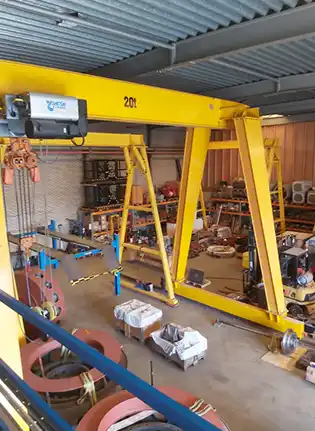20 Ton Single Girder Gantry Crane Design Case for Netherlands
20 ton gantry crane for sale. Check our 20 ton single girder gantry crane design, optimizing efficiency & productivity in Netherlands' industrial use.
20 Ton Single Girder Gantry Crane Design Case Study for Netherlands
Our project focuses on the implementation of 20 ton single girder gantry cranes in the Netherlands. These cranes, with their European-style design and superior functionality, promise to revolutionize material handling operations across the country. By providing a detailed analysis and case study, we aim to shed light on the benefits and practicalities of integrating these cranes into industrial settings.
Gantry Cranes in the Netherlands
The Netherlands boasts a diverse and dynamic industrial landscape, characterized by its strong focus on innovation, sustainability, and efficiency. With key sectors including manufacturing, logistics, maritime, and construction, the country plays a pivotal role in the global supply chain.
Gantry cranes are integral to the operations of numerous industries in the Netherlands. In the manufacturing sector, they facilitate the movement of heavy machinery and components, enhancing production efficiency and reducing downtime. Logistics companies rely on gantry cranes for loading and unloading cargo containers at ports and warehouses, ensuring swift and organized handling of goods. Moreover, in the construction industry, gantry cranes are indispensable for lifting and positioning building materials, accelerating construction timelines and improving safety.
To ensure the safety and reliability of crane operations, the Netherlands has established stringent regulations and standards governing their design, installation, and maintenance. These regulations, enforced by organizations such as the Dutch Working Conditions Act (Arbowet) and the Dutch Association for Vertical Transport (Verticaal Transport Nederland), cover aspects such as load capacity, structural integrity, and operator training. Compliance with these regulations is essential for all gantry crane installations in the country, underscoring the importance of selecting cranes that meet or exceed these requirements.
In summary, the Netherlands presents a thriving market for gantry cranes, driven by the diverse needs of its industrial sectors and governed by robust safety and quality standards.
Technical Specifications of the 20 Ton Gantry Crane
When it comes to gantry cranes, various types are available to suit different industrial applications. These include single girder gantry cranes, double girder gantry cranes, and semi-gantry cranes. Each type offers unique advantages in terms of load capacity, span, and lifting height, allowing businesses to select the most suitable option based on their specific requirements.
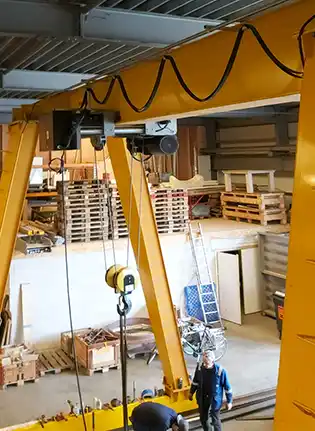 20 ton low headroom gantry crane for sale
20 ton low headroom gantry crane for saleBox Girder Gantry Cranes with European Style Single Girder Crane Design
In our case, we focus on box girder gantry cranes with a European-style single girder crane design. These cranes combine the robustness of box girder construction with the efficiency and compactness of a single girder configuration. The European-style design emphasizes reliability, precision, and ease of maintenance, making it ideal for demanding industrial environments.
The single girder configuration offers several benefits, including reduced weight, lower headroom requirements, and simplified installation and maintenance procedures. This design is well-suited for applications where space is limited or where a lighter crane structure is preferred without compromising on lifting capacity.
By opting for a box girder construction, these cranes offer exceptional strength and stability, ensuring reliable performance even under heavy loads and harsh operating conditions. Additionally, the European-style design incorporates advanced safety features and ergonomic controls, enhancing operator comfort and minimizing the risk of accidents.
In summary, the 20 ton gantry crane with a box girder and European-style single girder design represents a versatile and efficient solution for material handling tasks in the Netherlands. Its combination of strength, precision, and safety makes it a valuable asset for industries seeking to enhance productivity and streamline their operations.
Detailed Specifications of the 20 Ton Gantry Crane
Detailed specifications:
Crane capacity: 20 ton
Crane span: 7.5 meters
Crane lifting height: 5 meters
Power requirements: 400V/50HZ/3P
- Crane Capacity: 20 Ton : The crane is designed to handle heavy loads of up to 20 tons with ease and precision. This robust capacity ensures that it can efficiently lift and transport a wide range of materials, from machinery components to bulk cargo containers, thereby optimizing productivity in industrial settings.
- Crane Span: 7.5 Meters : With a span of 7.5 meters, the crane provides ample coverage for material handling operations within its designated area. This optimal span width allows for efficient movement of loads across various workstations or storage areas, minimizing the need for repositioning and maximizing workflow efficiency.
- Crane Lifting Height: 5 Meters : The crane offers a lifting height of 5 meters, enabling it to reach elevated positions with ease. This vertical clearance accommodates the stacking and positioning of materials at different levels, facilitating efficient storage, assembly, or loading/unloading operations within the facility.
- Power Requirements: 400V/50Hz/3P : The crane operates on a standard power supply of 400 volts, 50 Hertz, and three phases. This power configuration ensures consistent and reliable performance, allowing the crane to operate seamlessly in industrial environments without interruptions or fluctuations in power supply. Additionally, the compatibility with standard power specifications simplifies installation and maintenance procedures, contributing to overall operational efficiency.
In summary, the detailed specifications of the 20 ton gantry crane underscore its suitability for handling heavy loads with precision and efficiency. With its optimal capacity, span, lifting height, and power requirements, the crane offers a versatile solution for material handling tasks in diverse industrial applications.
Design Considerations for the 20 Ton Gantry Crane
- Structural Design of the Crane: The structural design of the gantry crane is meticulously engineered to ensure optimal strength, stability, and durability. Utilizing advanced CAD software and finite element analysis (FEA), the crane's framework is designed to withstand the rigors of heavy-duty material handling operations. The box girder construction provides exceptional torsional rigidity, minimizing deflection and ensuring precise load handling.
- Material Selection for Durability and Performance : In selecting materials for the gantry crane, emphasis is placed on durability, corrosion resistance, and performance under varying environmental conditions. High-strength steel components are employed in critical load-bearing areas to withstand the stresses of lifting heavy loads. Additionally, protective coatings and surface treatments are applied to safeguard against corrosion, extending the crane's lifespan and reducing maintenance requirements.
- Safety Features and Compliance with European Standards : Safety is paramount in the design of the gantry crane, with a comprehensive array of safety features integrated into its design. This includes overload protection mechanisms, emergency stop buttons, and limit switches to prevent accidents and ensure the safety of personnel and equipment. Moreover, the crane is designed and manufactured in compliance with stringent European standards, including EN 13001, EN 14439, and EN 60204, guaranteeing adherence to strict safety and quality regulations.
- Adaptability to the Netherlands' Working Environment and Climate : The gantry crane is engineered to thrive in the Netherlands' diverse working environment and climate conditions. Special attention is paid to factors such as temperature fluctuations, humidity, and exposure to harsh elements. Corrosion-resistant coatings and weatherproofing measures are incorporated to withstand outdoor use and protect against corrosion, rust, and degradation over time. Additionally, the crane's electrical components and wiring are designed to withstand voltage fluctuations and electrical disturbances commonly encountered in industrial settings.
In summary, the design considerations of the 20 ton gantry crane prioritize structural integrity, durability, safety, and adaptability to ensure optimal performance in the Netherlands' industrial landscape. By addressing these key factors, the crane offers a reliable and efficient solution for material handling applications across various sectors.
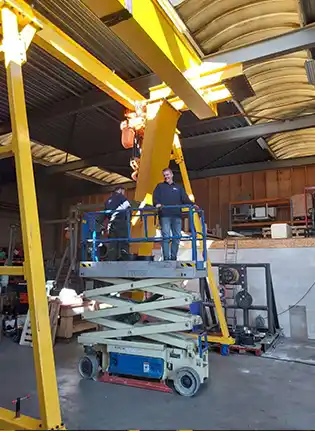 20 ton single girder gantry crane assembly
20 ton single girder gantry crane assembly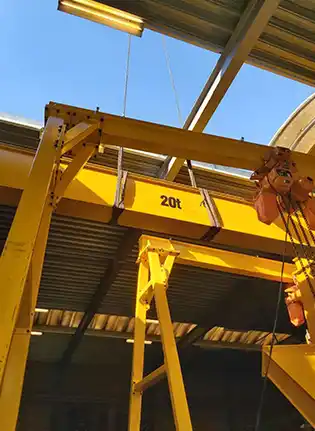 gantry crane assembly
gantry crane assembly Implementation of 20 Ton Single Girder Gantry Crane in the Netherlands
- Overview of the Project Location and Client Requirements: The project took place in Rotterdam, one of the largest ports in Europe and a key hub for maritime trade and logistics in the Netherlands. The client, a leading manufacturing company specializing in heavy machinery components, sought to enhance their material handling capabilities to meet growing demand and improve operational efficiency.
- The client's primary requirements included the need for a gantry crane with a 20 ton lifting capacity, suitable for handling large machinery components and containers. Additionally, the crane needed to have a span of 7.5 meters and a lifting height of 5 meters to accommodate the facility's layout and operational needs.
- Planning and Installation Process : The planning and installation process commenced with a detailed site assessment and consultation with the client to understand their specific requirements and operational constraints. Based on this assessment, a customized gantry crane solution was designed to meet the client's needs while adhering to safety and regulatory standards.
- Once the design was finalized, the installation process began, involving the assembly of structural components, installation of electrical systems, and integration of safety features. A team of experienced technicians and engineers coordinated the installation process, ensuring precision and efficiency at every step.
- Challenges Faced During Implementation: Several challenges were encountered during the implementation phase, including logistical constraints, site-specific challenges, and adherence to strict safety regulations. The proximity of the installation site to active operational areas within the facility posed logistical challenges, requiring careful coordination to minimize disruptions to ongoing operations.
- Additionally, the site presented structural limitations that required innovative engineering solutions to ensure the stability and integrity of the gantry crane installation. Furthermore, compliance with stringent safety standards and regulations, including those set forth by the Dutch Working Conditions Act and industry-specific guidelines, added complexity to the implementation process.
- Solutions and Successful Outcomes : Despite the challenges faced, the project was successfully completed within the stipulated timeline and budget, thanks to proactive planning, meticulous execution, and effective problem-solving strategies. Innovative engineering solutions were implemented to overcome site-specific challenges, ensuring the structural integrity and safety of the gantry crane installation.
By leveraging advanced technology and expertise, the gantry crane was seamlessly integrated into the client's operations, providing reliable and efficient material handling capabilities. The crane's robust design, precision controls, and advanced safety features have significantly enhanced productivity and safety at the client's facility, enabling them to meet growing demand and maintain a competitive edge in the market.
In summary, the implementation of the 20 ton single girder gantry crane in the Netherlands exemplifies the successful collaboration between technology, expertise, and innovation to address complex industrial challenges and deliver tangible results for clients.
Economic Analysis of the 20 Ton Single Girder Gantry Crane
Cost Estimation for the Gantry Crane
The initial cost estimation for the 20 ton single girder gantry crane encompasses various factors, including equipment procurement, installation expenses, and ongoing maintenance costs. The cost breakdown includes:
- Equipment Procurement: The cost of purchasing the gantry crane, including structural components, electrical systems, and control mechanisms.
- Installation Expenses: Costs associated with site preparation, crane assembly, electrical wiring, and commissioning.
- Ongoing Maintenance: Anticipated costs for routine maintenance, inspections, and repairs over the crane's operational lifespan.
Long-term Cost Benefits Compared to Alternative Solutions
While the initial investment in the gantry crane may seem substantial, it offers significant long-term cost benefits compared to alternative material handling solutions. These benefits include:
- Enhanced Productivity: The gantry crane's high lifting capacity, precision controls, and efficient operation result in increased productivity and throughput, reducing operational downtime and labor costs.
- Reduced Material Handling Expenses: By streamlining material handling processes and minimizing manual handling, the gantry crane helps reduce material wastage, damage, and loss, leading to cost savings over time.
- Improved Safety: The advanced safety features of the gantry crane minimize the risk of accidents and workplace injuries, resulting in lower insurance premiums and liability costs for the company.
- Longevity and Durability: The gantry crane's robust construction and quality materials ensure durability and longevity, reducing the need for frequent replacements and associated capital expenditures.
Return on Investment Analysis
A return on investment (ROI) analysis is conducted to assess the financial viability of the gantry crane investment. This analysis compares the total cost of ownership, including initial investment and operational expenses, to the projected financial benefits over the crane's lifespan. Key factors considered in the ROI analysis include:
- Payback Period: The time required for the cumulative cost savings generated by the gantry crane to offset the initial investment.
- Net Present Value (NPV): The difference between the present value of cash inflows (cost savings) and outflows (investment and operating expenses), adjusted for the time value of money.
- Internal Rate of Return (IRR): The discount rate at which the net present value of cash flows equals zero, indicating the rate of return on the investment.
By conducting a comprehensive ROI analysis, stakeholders can make informed decisions regarding the gantry crane investment, quantifying the financial benefits and assessing its impact on overall business performance.
In conclusion, the economic analysis demonstrates the cost-effectiveness and financial benefits of the 20 ton single girder gantry crane compared to alternative material handling solutions. By optimizing productivity, reducing costs, and enhancing safety, the gantry crane proves to be a strategic investment that delivers long-term value for businesses in the Netherlands.
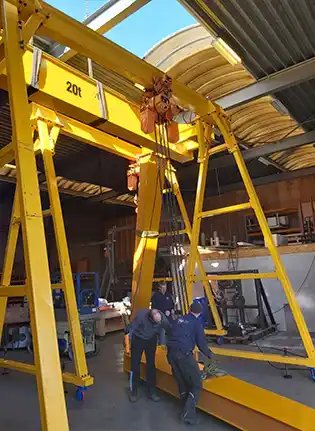 single girder gantry crane 20 ton installation
single girder gantry crane 20 ton installation 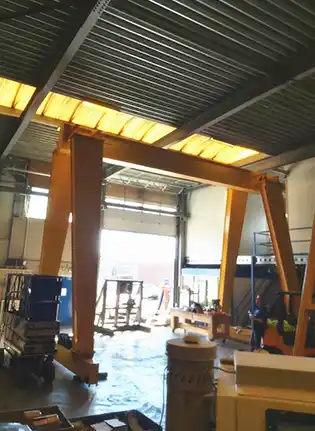 Finished intallation in workshop
Finished intallation in workshop Environmental Impact Assessment of the 20 Ton Single Girder Gantry Crane
Energy Efficiency of the Crane
The 20 ton single girder gantry crane is designed with energy efficiency in mind, incorporating advanced technologies and design features to minimize energy consumption. Key factors contributing to its energy efficiency include:
- Variable Frequency Drives (VFDs): The crane is equipped with VFDs for precise control of motor speed, allowing for optimal energy usage based on the load requirements. This ensures that energy is only consumed when necessary, reducing wastage and lowering operating costs.
- Regenerative Braking Systems: Regenerative braking systems are implemented to capture and store energy generated during deceleration or lowering of loads. This energy is then recycled and reused within the crane's electrical system, further enhancing energy efficiency and reducing overall power consumption.
- LED Lighting: The gantry crane is outfitted with energy-efficient LED lighting fixtures, which consume significantly less energy compared to traditional lighting sources while providing adequate illumination for safe operation during day and night.
Reduction of Carbon Footprint Compared to Alternative Solutions
Compared to alternative material handling solutions such as diesel-powered cranes or manual labor, the 20 ton single girder gantry crane offers substantial reductions in carbon emissions and environmental impact. Key factors contributing to the reduction of carbon footprint include:
- Electrification: The gantry crane operates solely on electricity, eliminating the need for fossil fuels and reducing greenhouse gas emissions associated with combustion engines.
- Energy Efficiency: By optimizing energy usage through VFDs and regenerative braking systems, the crane minimizes overall energy consumption, resulting in lower carbon emissions over its operational lifespan.
- Reduced Material Handling: The gantry crane's efficiency and precision minimize material wastage and product damage, reducing the environmental impact associated with resource extraction, manufacturing, and transportation.
Compliance with Environmental Regulations in the Netherlands
The design and operation of the 20 ton single girder gantry crane adhere to strict environmental regulations in the Netherlands, ensuring compliance with applicable standards and requirements. This includes:
- Emission Standards: The crane meets or exceeds emission standards set forth by regulatory authorities, ensuring that its operation does not contribute to air pollution or environmental degradation.
- Noise Regulations: Noise emissions from the crane are within acceptable limits as per Dutch environmental regulations, minimizing disturbance to surrounding communities and ecosystems.
- Waste Management: The gantry crane is designed for durability and longevity, reducing the generation of waste associated with frequent equipment replacements. Additionally, any waste generated during installation or maintenance is managed and disposed of in accordance with environmental regulations.
In summary, the 20 ton single girder gantry crane demonstrates a commitment to environmental sustainability through its energy-efficient design, reduction of carbon footprint, and compliance with stringent environmental regulations in the Netherlands. By prioritizing environmental considerations, the crane provides a responsible and eco-friendly solution for material handling applications in industrial settings.
Conclusion: Enhancing Efficiency with 20 Ton Single Girder Gantry Cranes
In conclusion, the analysis of the 20 ton single girder gantry crane highlights its significant contributions to enhancing efficiency, productivity, and safety in material handling operations. Key findings include:
The gantry crane's robust design, precise controls, and advanced safety features make it well-suited for handling heavy loads with efficiency and reliability.
Its energy-efficient operation, reduction of carbon footprint, and compliance with environmental regulations align with sustainability goals and environmental stewardship.
Through careful planning, installation, and adherence to safety standards, the gantry crane offers a strategic investment that delivers long-term value for businesses in the Netherlands.
In conclusion, the 20 ton single girder gantry crane emerges as a highly suitable solution for the Netherlands market, offering a perfect balance of performance, reliability, and sustainability. Its versatility, efficiency, and compliance with stringent regulations make it an indispensable asset for industries across various sectors, including manufacturing, logistics, and construction.
As the Netherlands continues to prioritize innovation, efficiency, and environmental responsibility, the 20 ton single girder gantry crane stands poised to play a pivotal role in driving progress and prosperity in the nation's industrial landscape. With its ability to enhance productivity, minimize environmental impact, and ensure workplace safety, the gantry crane represents a valuable investment for businesses seeking to thrive in today's dynamic and competitive market environment.


